Chaoyue Niu
Query Routing for Retrieval-Augmented Language Models
May 29, 2025Abstract:Retrieval-Augmented Generation (RAG) significantly improves the performance of Large Language Models (LLMs) on knowledge-intensive tasks. However, varying response quality across LLMs under RAG necessitates intelligent routing mechanisms, which select the most suitable model for each query from multiple retrieval-augmented LLMs via a dedicated router model. We observe that external documents dynamically affect LLMs' ability to answer queries, while existing routing methods, which rely on static parametric knowledge representations, exhibit suboptimal performance in RAG scenarios. To address this, we formally define the new retrieval-augmented LLM routing problem, incorporating the influence of retrieved documents into the routing framework. We propose RAGRouter, a RAG-aware routing design, which leverages document embeddings and RAG capability embeddings with contrastive learning to capture knowledge representation shifts and enable informed routing decisions. Extensive experiments on diverse knowledge-intensive tasks and retrieval settings show that RAGRouter outperforms the best individual LLM by 3.61% on average and existing routing methods by 3.29%-9.33%. With an extended score-threshold-based mechanism, it also achieves strong performance-efficiency trade-offs under low-latency constraints.
Automated Privacy Information Annotation in Large Language Model Interactions
May 27, 2025Abstract:Users interacting with large language models (LLMs) under their real identifiers often unknowingly risk disclosing private information. Automatically notifying users whether their queries leak privacy and which phrases leak what private information has therefore become a practical need. Existing privacy detection methods, however, were designed for different objectives and application scenarios, typically tagging personally identifiable information (PII) in anonymous content. In this work, to support the development and evaluation of privacy detection models for LLM interactions that are deployable on local user devices, we construct a large-scale multilingual dataset with 249K user queries and 154K annotated privacy phrases. In particular, we build an automated privacy annotation pipeline with cloud-based strong LLMs to automatically extract privacy phrases from dialogue datasets and annotate leaked information. We also design evaluation metrics at the levels of privacy leakage, extracted privacy phrase, and privacy information. We further establish baseline methods using light-weight LLMs with both tuning-free and tuning-based methods, and report a comprehensive evaluation of their performance. Evaluation results reveal a gap between current performance and the requirements of real-world LLM applications, motivating future research into more effective local privacy detection methods grounded in our dataset.
Collaborative Learning of On-Device Small Model and Cloud-Based Large Model: Advances and Future Directions
Apr 17, 2025Abstract:The conventional cloud-based large model learning framework is increasingly constrained by latency, cost, personalization, and privacy concerns. In this survey, we explore an emerging paradigm: collaborative learning between on-device small model and cloud-based large model, which promises low-latency, cost-efficient, and personalized intelligent services while preserving user privacy. We provide a comprehensive review across hardware, system, algorithm, and application layers. At each layer, we summarize key problems and recent advances from both academia and industry. In particular, we categorize collaboration algorithms into data-based, feature-based, and parameter-based frameworks. We also review publicly available datasets and evaluation metrics with user-level or device-level consideration tailored to collaborative learning settings. We further highlight real-world deployments, ranging from recommender systems and mobile livestreaming to personal intelligent assistants. We finally point out open research directions to guide future development in this rapidly evolving field.
Personalized Language Model Learning on Text Data Without User Identifiers
Jan 10, 2025



Abstract:In many practical natural language applications, user data are highly sensitive, requiring anonymous uploads of text data from mobile devices to the cloud without user identifiers. However, the absence of user identifiers restricts the ability of cloud-based language models to provide personalized services, which are essential for catering to diverse user needs. The trivial method of replacing an explicit user identifier with a static user embedding as model input still compromises data anonymization. In this work, we propose to let each mobile device maintain a user-specific distribution to dynamically generate user embeddings, thereby breaking the one-to-one mapping between an embedding and a specific user. We further theoretically demonstrate that to prevent the cloud from tracking users via uploaded embeddings, the local distributions of different users should either be derived from a linearly dependent space to avoid identifiability or be close to each other to prevent accurate attribution. Evaluation on both public and industrial datasets using different language models reveals a remarkable improvement in accuracy from incorporating anonymous user embeddings, while preserving real-time inference requirement.
Personalized LLM for Generating Customized Responses to the Same Query from Different Users
Dec 16, 2024Abstract:Existing work on large language model (LLM) personalization assigned different responding roles to LLM, but overlooked the diversity of questioners. In this work, we propose a new form of questioner-aware LLM personalization, generating different responses even for the same query from different questioners. We design a dual-tower model architecture with a cross-questioner general encoder and a questioner-specific encoder. We further apply contrastive learning with multi-view augmentation, pulling close the dialogue representations of the same questioner, while pulling apart those of different questioners. To mitigate the impact of question diversity on questioner-contrastive learning, we cluster the dialogues based on question similarity and restrict the scope of contrastive learning within each cluster. We also build a multi-questioner dataset from English and Chinese scripts and WeChat records, called MQDialog, containing 173 questioners and 12 responders. Extensive evaluation with different metrics shows a significant improvement in the quality of personalized response generation.
Edge-Cloud Routing for Text-to-Image Model with Token-Level Multi-Metric Prediction
Nov 21, 2024



Abstract:Large text-to-image models demonstrate impressive generation capabilities; however, their substantial size necessitates expensive cloud servers for deployment. Conversely, light-weight models can be deployed on edge devices at lower cost but often with inferior generation quality for complex user prompts. To strike a balance between performance and cost, we propose a routing framework, called \texttt{RouteT2I}, which dynamically selects either the large cloud model or the light-weight edge model for each user prompt. Since generated image quality is challenging to measure directly, \texttt{RouteT2I} establishes multi-dimensional quality metrics, particularly, by evaluating the similarity between the generated images and both positive and negative texts that describe each specific quality metric. \texttt{RouteT2I} then predicts the expected quality of the generated images by identifying key tokens in the prompt and comparing their impact on the quality. \texttt{RouteT2I} further introduces the Pareto relative superiority to compare the multi-metric quality of the generated images. Based on this comparison and predefined cost constraints, \texttt{RouteT2I} allocates prompts to either the edge or the cloud. Evaluation reveals that \texttt{RouteT2I} significantly reduces the number of requesting large cloud model while maintaining high-quality image generation.
DC-CCL: Device-Cloud Collaborative Controlled Learning for Large Vision Models
Mar 18, 2023Abstract:Many large vision models have been deployed on the cloud for real-time services. Meanwhile, fresh samples are continuously generated on the served mobile device. How to leverage the device-side samples to improve the cloud-side large model becomes a practical requirement, but falls into the dilemma of no raw sample up-link and no large model down-link. Specifically, the user may opt out of sharing raw samples with the cloud due to the concern of privacy or communication overhead, while the size of some large vision models far exceeds the mobile device's runtime capacity. In this work, we propose a device-cloud collaborative controlled learning framework, called DC-CCL, enabling a cloud-side large vision model that cannot be directly deployed on the mobile device to still benefit from the device-side local samples. In particular, DC-CCL vertically splits the base model into two submodels, one large submodel for learning from the cloud-side samples and the other small submodel for learning from the device-side samples and performing device-cloud knowledge fusion. Nevertheless, on-device training of the small submodel requires the output of the cloud-side large submodel to compute the desired gradients. DC-CCL thus introduces a light-weight model to mimic the large cloud-side submodel with knowledge distillation, which can be offloaded to the mobile device to control its small submodel's optimization direction. Given the decoupling nature of two submodels in collaborative learning, DC-CCL also allows the cloud to take a pre-trained model and the mobile device to take another model with a different backbone architecture.
One-Time Model Adaptation to Heterogeneous Clients: An Intra-Client and Inter-Image Attention Design
Nov 11, 2022Abstract:The mainstream workflow of image recognition applications is first training one global model on the cloud for a wide range of classes and then serving numerous clients, each with heterogeneous images from a small subset of classes to be recognized. From the cloud-client discrepancies on the range of image classes, the recognition model is desired to have strong adaptiveness, intuitively by concentrating the focus on each individual client's local dynamic class subset, while incurring negligible overhead. In this work, we propose to plug a new intra-client and inter-image attention (ICIIA) module into existing backbone recognition models, requiring only one-time cloud-based training to be client-adaptive. In particular, given a target image from a certain client, ICIIA introduces multi-head self-attention to retrieve relevant images from the client's historical unlabeled images, thereby calibrating the focus and the recognition result. Further considering that ICIIA's overhead is dominated by linear projection, we propose partitioned linear projection with feature shuffling for replacement and allow increasing the number of partitions to dramatically improve efficiency without scarifying too much accuracy. We finally evaluate ICIIA using 3 different recognition tasks with 9 backbone models over 5 representative datasets. Extensive evaluation results demonstrate the effectiveness and efficiency of ICIIA. Specifically, for ImageNet-1K with the backbone models of MobileNetV3-L and Swin-B, ICIIA can improve the testing accuracy to 83.37% (+8.11%) and 88.86% (+5.28%), while adding only 1.62% and 0.02% of FLOPs, respectively.
Walle: An End-to-End, General-Purpose, and Large-Scale Production System for Device-Cloud Collaborative Machine Learning
May 30, 2022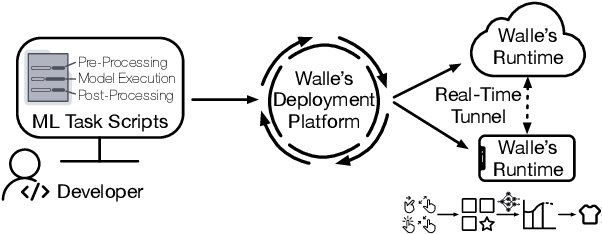

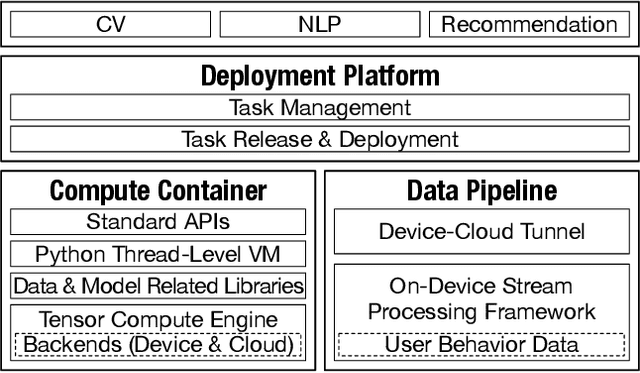
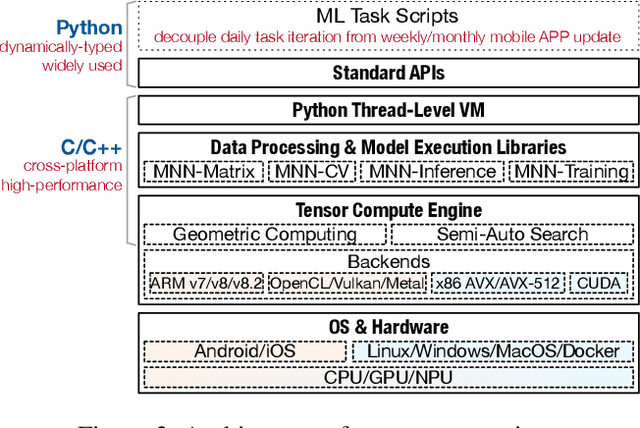
Abstract:To break the bottlenecks of mainstream cloud-based machine learning (ML) paradigm, we adopt device-cloud collaborative ML and build the first end-to-end and general-purpose system, called Walle, as the foundation. Walle consists of a deployment platform, distributing ML tasks to billion-scale devices in time; a data pipeline, efficiently preparing task input; and a compute container, providing a cross-platform and high-performance execution environment, while facilitating daily task iteration. Specifically, the compute container is based on Mobile Neural Network (MNN), a tensor compute engine along with the data processing and model execution libraries, which are exposed through a refined Python thread-level virtual machine (VM) to support diverse ML tasks and concurrent task execution. The core of MNN is the novel mechanisms of operator decomposition and semi-auto search, sharply reducing the workload in manually optimizing hundreds of operators for tens of hardware backends and further quickly identifying the best backend with runtime optimization for a computation graph. The data pipeline introduces an on-device stream processing framework to enable processing user behavior data at source. The deployment platform releases ML tasks with an efficient push-then-pull method and supports multi-granularity deployment policies. We evaluate Walle in practical e-commerce application scenarios to demonstrate its effectiveness, efficiency, and scalability. Extensive micro-benchmarks also highlight the superior performance of MNN and the Python thread-level VM. Walle has been in large-scale production use in Alibaba, while MNN has been open source with a broad impact in the community.
On-Device Learning with Cloud-Coordinated Data Augmentation for Extreme Model Personalization in Recommender Systems
Jan 24, 2022
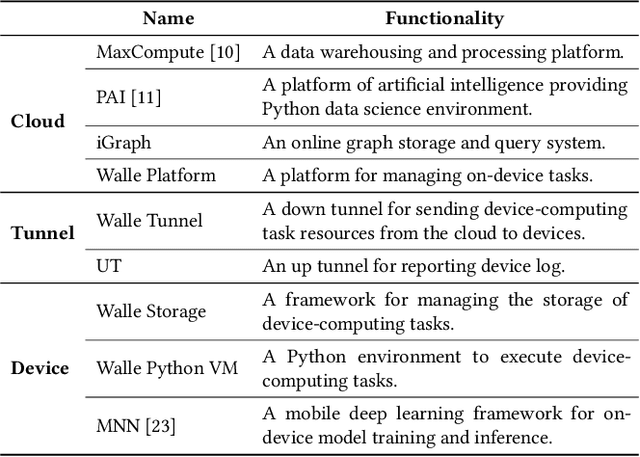

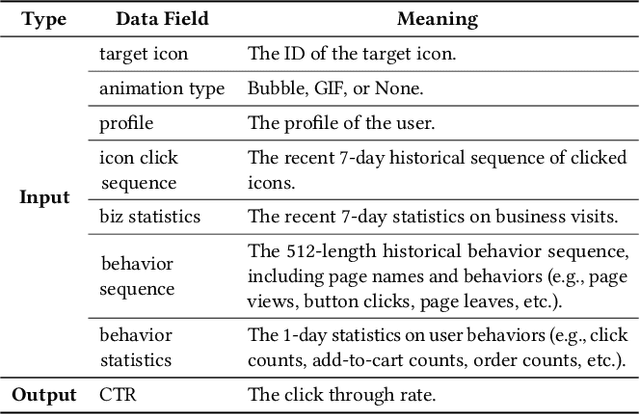
Abstract:Data heterogeneity is an intrinsic property of recommender systems, making models trained over the global data on the cloud, which is the mainstream in industry, non-optimal to each individual user's local data distribution. To deal with data heterogeneity, model personalization with on-device learning is a potential solution. However, on-device training using a user's small size of local samples will incur severe overfitting and undermine the model's generalization ability. In this work, we propose a new device-cloud collaborative learning framework, called CoDA, to break the dilemmas of purely cloud-based learning and on-device learning. The key principle of CoDA is to retrieve similar samples from the cloud's global pool to augment each user's local dataset to train the recommendation model. Specifically, after a coarse-grained sample matching on the cloud, a personalized sample classifier is further trained on each device for a fine-grained sample filtering, which can learn the boundary between the local data distribution and the outside data distribution. We also build an end-to-end pipeline to support the flows of data, model, computation, and control between the cloud and each device. We have deployed CoDA in a recommendation scenario of Mobile Taobao. Online A/B testing results show the remarkable performance improvement of CoDA over both cloud-based learning without model personalization and on-device training without data augmentation. Overhead testing on a real device demonstrates the computation, storage, and communication efficiency of the on-device tasks in CoDA.
 Add to Chrome
Add to Chrome Add to Firefox
Add to Firefox Add to Edge
Add to Edge